Greater Anglia facts for kids
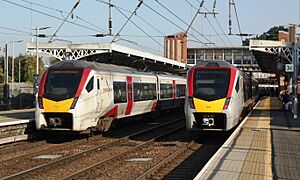
Greater Anglia Class 745 and Class 755 units side by side at Ipswich
|
|
| Overview | |
|---|---|
| Franchise(s) | Greater Anglia 5 February 2012 – 15 October 2016 East Anglia 16 October 2016 – 12 October 2025 |
| Main region(s) | East of England |
| Other region(s) | Greater London |
| Fleet size |
Aventra
FLIRT
FLIRT |
| Stations called at | 150 |
| Stations operated | 134 |
| Parent company | Transport UK Group (60%) Mitsui & Co (40%) |
| Reporting mark | LE |
| Predecessor | National Express East Anglia |
Greater Anglia is a British train company. It is owned by two groups: Transport UK Group and Mitsui & Co. This company runs trains in the East of England region. Its main station in London is London Liverpool Street. From there, trains go to places like Essex, Suffolk, Norfolk, and parts of Hertfordshire and Cambridgeshire. Greater Anglia also operates many local train services across the East of England.
The company started running these trains on 4 February 2012. It took over from another company called National Express East Anglia. At first, it was called "Greater Anglia," then it changed to "Abellio Greater Anglia" in December 2013. The company worked on making services better. This included getting new trains and starting a plan called Norwich in 90. This plan aimed to make journeys faster between major cities. In May 2015, some of Greater Anglia's local services were moved to London Overground and TfL Rail.
In August 2016, Greater Anglia won the right to keep running the trains until 2025. It went back to being called "Greater Anglia" on 16 October 2016. In 2017, a Japanese company, Mitsui, bought a 40% share in Greater Anglia. Since then, Greater Anglia has used some Japanese ideas for planning and running its trains. There have been some disagreements with train worker unions, which led to strikes in 2017 and 2018.
In December 2024, it was announced that Greater Anglia would become a public company. This means the government would take over its operations. This change is planned for 12 October 2025.
Contents
How Greater Anglia Started
Early Days of the Franchise
In 2003, a company called National Express started running trains in the East Anglia area. This was on 1 April 2004. Their contract was supposed to last until March 2011. However, the government decided not to extend their contract. This was because another National Express train service had problems.
After a change in government in 2010, all new train contracts were put on hold. So, National Express East Anglia's contract was extended a few times. It finally ended in February 2012.
In March 2011, three companies were chosen to bid for the new contract. These were Abellio, Go-Ahead, and Stagecoach. In October 2011, Abellio won the contract. Greater Anglia then took over the train services on 5 February 2012.
The first contract for Greater Anglia was short, ending in July 2014. This was to allow the government to review how train services were run. In March 2013, the contract was extended again until 15 October 2016. In December 2013, Greater Anglia changed its brand name to Abellio Greater Anglia.
Making Improvements to Services
Before Greater Anglia took over, there had not been many big improvements to the train lines for almost 30 years. When Greater Anglia started, many people felt that changes were needed. The company promised to invest money to make services and stations better. In November 2014, a report showed many planned improvements for the train network.
One important plan was the 'Norwich in 90' campaign. This aimed to make journeys faster. For example, London to Colchester in 40 minutes, London to Ipswich in 60 minutes, and London to Norwich in 90 minutes. People had been asking for faster trains since 2009. Greater Anglia knew about these requests. However, they could not make huge investments during their first short contract. A special group was formed in 2013 to help with this. In 2015, a local MP said the plan was about politics as much as engineering.
By the 2010s, the train lines in the region were old and often had problems. So, the goal was not just to make trains faster. It was also to make them more reliable. Many groups worked together on this. This included changing the tracks and getting new trains. To make intercity trains faster, all trains on the line needed to speed up. This is because slower local trains could not easily be passed on the mostly two-track lines. There was also a wish to have three trains per hour between Norwich and London. But this would need changes to the tracks in some areas.
Some train services were moved to other companies. On 31 May 2015, services from Liverpool Street to Enfield Town, Cheshunt, and Chingford were moved to London Overground Rail Operations. Also, the Romford to Upminster service moved. On the same day, local services from Liverpool Street to Shenfield were moved to TfL Rail.
In June 2015, several companies wanted to bid for the new contract. These included Abellio, Stagecoach, FirstGroup, and National Express. In December 2015, Stagecoach decided not to bid with Abellio. Abellio continued alone. In August 2016, Abellio won the contract again until 2025. As part of this new contract, they bought 1,043 new train carriages. Some were built by Bombardier Transportation and others by Stadler Rail. In January 2017, Abellio agreed to sell a 40% share of the business to Mitsui. This sale was completed in March 2017. Since then, Greater Anglia has used many planning ideas from Japanese railways. For example, they use computer models to check how trains perform.
In 2021, Greater Anglia's contract was changed to a direct agreement. This new agreement will end on 20 September 2026.
In February 2023, Transport UK Group took over Abellio's business in the UK. This included its share in Greater Anglia.
Disagreements with Workers
In August 2017, train workers at Greater Anglia voted to go on strike. This was part of bigger train strikes happening across the country. The workers were unhappy about plans to close ticket offices. They also disagreed with plans to have more trains operated only by the driver. Since October 2017, there have been many strikes by some of the company's employees. The main problem has not been fully solved. The National Union of Rail, Maritime and Transport Workers (RMT) said that Greater Anglia used temporary staff during strikes. They claimed this put passengers' safety at risk. The disagreement continued into 2018, with more strikes planned for the summer. These strikes affected about 40% of the train services.
On 19 July 2018, the RMT announced that its members voted to accept a deal. This deal meant that train guards would stay on trains. It also stopped the plan to have more driver-only trains.
Greater Anglia is one of several train companies affected by the 2022–2024 United Kingdom railway strikes. These are the first national train strikes in the UK in 30 years. Greater Anglia workers are taking part in these strikes. They are asking for better pay and working conditions.
End of the Contract
Before the 2024 United Kingdom general election, the Labour Party said it wanted the British train network to be owned by the government again. After winning the election in 2024, the government passed a law to do this.
In December 2024, it was announced that Greater Anglia's contract would end in late 2025. The government decided to use a special clause to end the contract early. A new government-run company, Greater Anglia, will take over. In May 2025, the date was confirmed as 12 October 2025.
What Greater Anglia Promised
First Contract (2012–2016)
During its first contract, Greater Anglia planned several improvements:
- Better stations and ticket services.
- More information for passengers.
- A text message service to tell passengers about delays.
- Expanding Oyster card use on some lines.
- Mobile phone and print-at-home tickets.
- 600 more car parking spaces at stations.
- More places to store bicycles.
- New automatic ticket barriers at Brentwood. (Note: This barrier was not installed by Greater Anglia, and the station later moved to TfL Rail management).
Second Contract (2016–2025)
For its second contract, Abellio (Greater Anglia) promised these improvements:
- Replacing all old trains with 1,043 new ones by September 2020. These new trains would run on all major routes.
- Refurbishing some existing trains before they were replaced.
- Improving train punctuality to at least 92.9%.
- Two weekday trains between Norwich and London in 90 minutes. Also, between Ipswich and London in 60 minutes.
- Free Wi-Fi on trains and at stations.
- £60 million investment for station upgrades. This focused on Broxbourne, Cambridge, Cheshunt, Harlow Town, and Southend Victoria stations.
- New digital information screens at all stations.
- More car and cycle parking (1,800 and 4,000 extra spaces).
- Upgrades to ticket offices and vending machines.
- New ticket deals for people who travel less often or work part-time.
- Automatic refunds for delays for season and advance ticket holders.
- £120 million investment in train depots. This included a new maintenance place at Manningtree.
- Hiring 20 trainees each year and creating at least 30 apprenticeships by 2019.
- Extending the Gainsborough Line from Marks Tey to Colchester Town.
- Bringing back four direct trains from Lowestoft to London on the East Suffolk Line.
- Making the Ipswich to Ely Line services to Peterborough hourly instead of every two hours. Some extra services would go to Colchester.
- Making the Ipswich to Cambridge Line and East Suffolk Line services hourly on Sundays.
Train Services
As of May 2025[update], here are some of the train services Greater Anglia runs during quieter times, Monday to Friday:
Inter-City Services
| Route | tph | Calling at |
|---|---|---|
| London Liverpool Street – Norwich | 2 |
|
Great Eastern Services
| Great Eastern Main Line | ||
|---|---|---|
| Route | tph | Calling at |
| London Liverpool Street – Ipswich | 1 |
|
| Shenfield–Southend and Crouch Valley lines | ||
| Route | tph | Calling at |
| London Liverpool Street – Southend Victoria | 3 | |
| Wickford – Southminster | 3⁄2 |
|
| Braintree branch line | ||
| Route | tph | Calling at |
| London Liverpool Street – Braintree | 1 |
|
| Gainsborough line | ||
| Route | tph | Calling at |
| Marks Tey – Sudbury | 1 |
|
| Sunshine Coast Line | ||
| Route | tph | Calling at |
| London Liverpool Street – Colchester Town | 1 |
|
| London Liverpool Street – Clacton-on-Sea | 1 |
|
| Colchester – Colchester Town | 1 | Shuttle service |
| Colchester – Walton-on-the-Naze | 1 |
|
| Mayflower line | ||
| Route | tph | Calling at |
| Manningtree – Harwich Town | 1 |
|
West Anglia Services
| West Anglia Main Line | ||
|---|---|---|
| Route | tph | Calling at |
| Stratford – Meridian Water | 2 |
|
| Stratford – Bishop's Stortford | 2 |
|
| Hertford East branch line | ||
| Route | tph | Calling at |
| London Liverpool Street – Hertford East | 2 |
|
| London to Cambridge and Ely | ||
| Route | tph | Calling at |
| London Liverpool Street – Cambridge North | 2 |
|
| London Liverpool Street - Ely | 4tpd | Tottenham Hale, Cheshunt (1tpd), Broxbourne, Roydon (1tpd), Harlow Town (1tpd), Harlow Mill (1tpd), Sawbridgeworth (1tpd), Bishop's Stortford, Stansted Mountfitchet (1tpd), Elsenham (2tpd), Newport (2tpd), Audley End, Great Chesterford (2tpd), Whittlesford Parkway, Shelford (2tpd), Cambridge, Cambridge North (2tpd), Waterbeach
|
Regional Services
| Felixstowe branch line | ||
|---|---|---|
| Route | tph | Calling at |
| Ipswich – Felixstowe | 1 | |
| East Suffolk line | ||
| Route | tph | Calling at |
| Ipswich – Lowestoft | 1 |
|
| Ipswich–Ely line | ||
| Route | tph | Calling at |
| Ipswich – Cambridge | 1 |
|
| Ipswich – Peterborough | 1⁄2 |
|
| Bittern Line | ||
| Route | tph | Calling at |
| Norwich – Sheringham | 1 |
|
| Wherry Lines | ||
| Route | tph | Calling at |
| Norwich – Great Yarmouth | 1 |
|
| 2tpd |
|
|
| Norwich – Lowestoft | 1 |
|
| Breckland line | ||
| Route | tph | Calling at |
| Norwich – Stansted Airport | 1 |
|
Stansted Express Services
Greater Anglia also runs the Stansted Express. This is a special train service to Stansted Airport. As of May 2025[update], these trains run during quieter times, Monday to Friday:
| Route | tph | Calling at |
|---|---|---|
| London Liverpool Street - Stansted Airport | 4 |
|
Train Performance
In late 2013, Greater Anglia's trains were on time 94.0% of the time. This was a little less than the year before. In 2013, Greater Anglia was named "train operator of the year."
However, a survey in February 2014 found that customers were not very happy with Greater Anglia. It was ranked last out of 20 train companies, with only 40% satisfaction. In 2016, it was the fourth worst UK train operator for commuter services, with 35% satisfaction.
Around the mid-2010s, it was expected that more people would want to travel by train. Especially on the Great Eastern Main Line into London. This was true even though Greater Anglia received less money from the government than most other train companies.
Train Fleet
Greater Anglia took over many different types of trains from National Express East Anglia. Because its first contract was short, Greater Anglia did not plan to get new trains at first. But this changed a lot when its second contract started in October 2016.
In November 2013, people started a petition to stop trains from dropping waste directly onto the tracks. There were also worries that this "waste mist" could make train staff sick. Greater Anglia said it was working with the government to upgrade its trains. By October 2016, all older trains had new toilets that collected waste.
On 31 May 2015, some of Greater Anglia's Class 315 trains were moved to London Overground and TfL Rail. Some Class 317 trains also moved to London Overground.
In August 2016, it was announced that 1,043 new train carriages would be bought. This would replace all the old trains. Many old trains did not meet new rules for accessibility after 2020. They also could not meet the new goals for faster journey times. Bombardier built 111 new electric trains. Stadler built 58 new FLIRT electric trains. All these new trains started service between August 2019 and September 2020.
Bombardier's order included 111 Class 720 units. These trains took over local services from Liverpool Street. Stadler's order included 20 Class 745 units with 12 carriages. These trains run inter-city services on the Great Eastern Main Line and the Stansted Express. Stadler also built 38 Class 755 units with three or four carriages. These replaced all the old diesel trains. By July 2020, all Class 755 trains were in use.
The first new train to start service was a Class 755. It began running on 29 July 2019 on the Norwich to Great Yarmouth and Lowestoft routes. The first Class 745 train started service on 8 January 2020. It ran on the Great Eastern Main Line between Norwich and Liverpool Street. After these new trains arrived, the old Class 90 trains were taken out of service. The last one ran on 24 March 2020.
In March 2020, testing of the new Class 720 trains began. This continued even during the COVID-19 pandemic. The first two Class 720 trains started service on 26 November 2020. They ran together on the Shenfield to Southend Line.
Class 360 trains were moved for upgrades in June 2020. These upgrades made them able to go 110 mph. This was to prepare them for transfer to East Midlands Railway (EMR). Because the Class 720s were delayed, Greater Anglia leased some Class 321/9s and Class 322s from July 2020. All Class 360 trains had moved to EMR by February 2021.
The 30 Class 379 Electrostar trains were taken out of service in February 2022. This was because their leasing costs were too high.
On 1 August 2022, Greater Anglia confirmed that all West Anglia services were now run by Class 720 Aventra trains.
Greater Anglia removed its Class 321 trains from service at the end of April 2023.
Current Train Fleet
| Family | Class | Image | Type | Top speed | Number | Carriages | Routes operated | Built | |
|---|---|---|---|---|---|---|---|---|---|
| mph | km/h | ||||||||
| Shunting Locomotive | |||||||||
| 08 | N/A | Shunter | 15 | 24 | 3 | N/A | Moving trains around depots | 1952–1962 | |
| Electric Trains | |||||||||
| Bombardier Aventra | 720/1 | 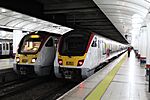 |
EMU | 100 | 161 | 44 | 5 |
|
2018–2021 |
| 720/5 | 89 | ||||||||
| Stadler FLIRT | 745/0 |  |
10 | 12 | 2018-2020 | ||||
| 745/1 | 10 | 12 | 2018-2020 | ||||||
| Bi-mode Trains (Electric and Diesel) | |||||||||
| Stadler FLIRT |
|
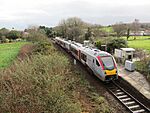 |
BMU | 100 | 161 | 14 | 3 |
|
2018–2020 |
| 24 | 4 | ||||||||
 |
|||||||||
Past Train Fleet
These are some of the train types Greater Anglia used to operate:
| Family | Class | Image | Type | Top speed | Cars | Number | Built | Routes operated | |||
|---|---|---|---|---|---|---|---|---|---|---|---|
| mph | km/h | ||||||||||
| Locomotive Hauled Trains | |||||||||||
| 37 |  |
Diesel locomotive | 80 | 130 | N/A | 4 | 1960–1965 | Wherry Lines | |||
| Stadler UKLight | 68 |  |
100 | 161 | 3 | 2013–2017 | |||||
| Mark 2 |  |
Carriage | 13 | 1963–1975 | |||||||
| 90 | 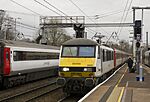 |
Electric locomotive | 110 | 177 | 9 | 15 | 1987–1990 | Great Eastern Main Line | |||
| Mark 3 |  |
Carriage | 125 | 201 | 130 | 1975–1988 | |||||
| Driving Van Trailer |  |
Control car | 15 | 1988–1990 | |||||||
| Diesel Trains | |||||||||||
| Super Sprinter | 153 | 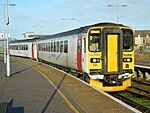 |
DMU | 75 | 121 | 1 | 5 | 1991–1992 |
|
||
| 156 |  |
2 | 9 | 1987–1988 | |||||||
| Bombardier Turbostar | 170/2 |  |
100 | 161 | 2 | 4 | 2002 | ||||
| 3 | 8 | 1999 | |||||||||
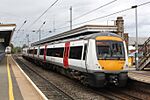 |
|||||||||||
| Electric Trains | |||||||||||
| BREL 1972 | 315 |  |
EMU | 75 | 121 | 4 | 61 | 1980–1981 | |||
| BR Second Generation (Mark 3) | 317/1 |  |
100 | 161 | 4 | 10 | 1981–1982 |
|
|||
| 317/5 |  |
7 | 1981–1982 |
|
|||||||
| 317/6 |  |
24 | 1985–1987 |
|
|||||||
| 317/7 |  |
9 | 1981–1982 | Lea Valley lines | |||||||
| 317/8 |  |
9 | |||||||||
| 321 |  |
100 | 161 | 4 | 89 | 1988–1991 |
|
||||
| 322 |  |
100 | 161 | 4 | 5 | 1990 |
|
||||
| Siemens Desiro | 360/1 | 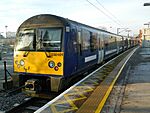 |
110 | 177 | 4 | 21 | 2002–2003 |
|
|||
| Bombardier Electrostar | 379 |  |
100 | 160 | 4 | 30 | 2010–2011 |
|
|||
 |
|||||||||||
Train Maintenance Depots
Greater Anglia's trains are looked after and repaired at three main places: the Clacton Servicing Depot, Ilford EMU Depot, and Crown Point TMD.

